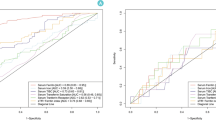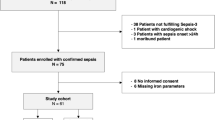Abstract
Serial measurements of blood haemoglobin, serum iron, serum transferrin, total iron-binding capacity, transferrin per cent saturation and serum ferritin were determined in 51 post-operative critically ill patients to investigate body iron status in severely stressed patients. The results showed decreased blood haemoglobin, serum iron, serum transferrin and transferrin saturation compared to an increase in serum ferritin levels. These results indicate that there is inadequate availability of iron to tissues (secondary to rearrangement of body iron to the advantage of the iron storage compartment), which is often present in severely critically ill patients. A positive correlation was found between the initial (ferritin) levels and SAPS (r=0.41,p< 0.01). In addition, the increase of ferritin concentration parallels a worsening of the clinical status in severely ill patients. This is due to enhanced release by the macrophage system. From this, we consider serum ferritin as an acute-phase protein and a useful marker of the severity of the clinical status. It appears to be useful in predicting the patient's outcome, but is not reliable in evaluating iron stores in stressed patients.
Similar content being viewed by others
References
Heubers H, Josephson B, Hebers E, Ctiba E, Finch C (1981) Uptake and release of iron from human transferrin. Proc Natl Acad Sci USA 78:2572
Finch CA, Huebers H (1982) Perspectives in iron metabolism. N Engl J Med 306:1520
Aisen P (1980) The transferrins. In: Jacobs A, Worwood M (eds) Iron in biochemistry and medicine, II. Academic Press, London, p 87
Cartwright GE (1966) The anemia of chronic disorders. Semin Hematol 3:351
Worwood M (1980) Serum ferritin. In: Jacobs A, Worwood M (eds) Iron biochemistry and medicine, II. Academic Press, London, p 203
Lipschitz DA, Cook JD, Finch A (1974) A clinical evaluation of serum ferritin as an index of iron stores. N Engl J Med 290:1213
Finch CA, Cook JD, Labbe RF, Colala M (1977) Effect of blood donation on iron stores as evaluated by serum ferritin. Blood 50:441
Jacobs A, Miller F, Worwood M (1972) Ferritin in the serum of the normal subjects and patients with iron deficiency and iron overload. Br Med J 4:206
Birgegard G (1979) Serum ferritin relation to the iron stores and changes during inflammation. Acta Univ Upsal (Thesis) 327:41
Thomson ABR, Brust R, Ali MAM (1978) Iron deficiency in inflammatory bowel disease: diagnostic efficacy of serum ferritin. Am J Dig Dis 23:705
Jones PA, Miller FM, Worwood M (1978) Ferritin anaemia in leukaemia and Hodgkin's disease. Br J Cancer 27:212
Bothwell TH, Charlton RW, Cook JD, Finch CA (1979) Iron metabolism in man. Blackwell, Oxford, p 20
Prieto J, Barry M, Sherlock S (1975) Serum ferritin in patients with iron overload and with acute and chronic liver diseases. Gastroenterology 68:525
Commitee on Reference Values of the Scandinavian Society for Clinical Chemistry and Clinical Physiology (1975) Scand J Clin Lab Invest 35 [Suppl 144]:135
Sheehan RG, Newton MJ, Frenkel EP (1978) Evaluation of a package kit assay of serum ferritin and application to clinical of selected anaemias. Am J Clin Pathol 70:79
Le Gall JR, Loirat P, Alperowitch A (1984) A simplified acute physiology score for ICU patients. Crit Care Med 12:975
Dionigi R, Dominioni L, Jemos V (1985) Sepsis score and complement factor B for monitoring severely septic surgical patients and for predicting their survival. Eur Surg Res 17:269
Knaus WA, Draper EA, Wagner DP (1984) Prognosis from combined organ-system failure, a national study (abstract). Crit Care Med 12:239
Watters JM, Bessey PQ, Dinorello CA (1985) Effects of interleukin-1 in humans. Presented at the 46th Annual Meeting of the Society of University Surgeons, Boston, Feb 6–9
Lukens JN, Drew CR (1975) Iron deficiency and infection. Am J Dis Child 129:160
Goris RJA, Boekholtz T, Muytinck JKS (1985) Multiple organ failure: generalized autodestructive inflammation? Arch Surg 121:897
Goris RJA, Boekholtz WKF, Bebber IPT van (1986) Multiple organ failure and sepsis without bacteria. Arch Surg 121:897
Dormandy TL (1980) Free radical reaction in biological systems. Ann Roy Coll Surg 62:188
Wills ED (1965) Mechanism of lipid peroxide formation in tissues. Role of metals and haematin proteins in the catalysis of the oxidation of unsatured fatty acids. Biochem Biophys Acta 98:238
Gutteridge JMC (1982) Fate of oxygen free radicals in extracellular fluid. Biochem Soc Trans 10:72
Babior BM (1978) Oxygen-dependent microbial killing by phagocytes. N Engl J Med 298:721
Biemand P, Eijk HG van, Swaak AJG, Koster JF (1984) Iron mobilization from ferritin by superoxide derived from stimulated polymorphonuclear leukocytes. J Clin Invest 73:1576
Bannister JV, Bannister WH, Thornalley PJ (1984) The effect of ferritin iron loading on hydroxyl radical production. Life Chem Rep 2 [Suppl]:64
Halliwell B, Gutteridge JMC (1984) Oxygen toxicity, oxygen radicals, transition metals and disease. Biochem J 219:1
Ward PA, Till GO, Beauchamp C (1983) Evidence for role of hydroxyl radical in complement and neutrophil-mediated tissue injury. J Clin Invest 72:789
Fligiel SEG, Ward PA, Johnson KJ, Till GO (1984) Evidence for role of hydroxyl radicals in immune-complex-induced vasculitis. Am J Pathol 115:375
Author information
Authors and Affiliations
Rights and permissions
About this article
Cite this article
Bobbio-Pallavicini, F., Verde, G., Spriano, P. et al. Body iron status in critically ill patients: significance of serum ferritin. Intensive Care Med 15, 171–178 (1989). https://doi.org/10.1007/BF01058569
Received:
Accepted:
Issue Date:
DOI: https://doi.org/10.1007/BF01058569




